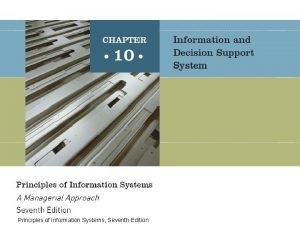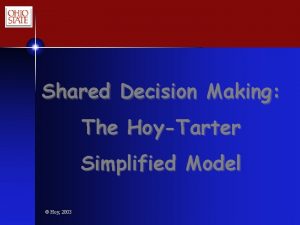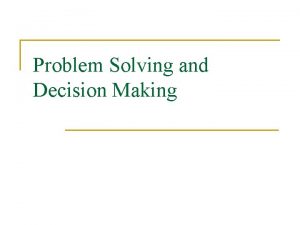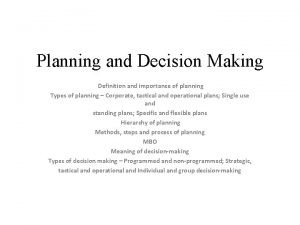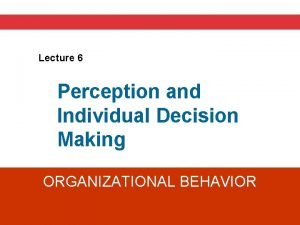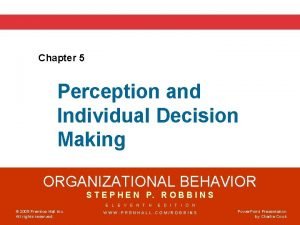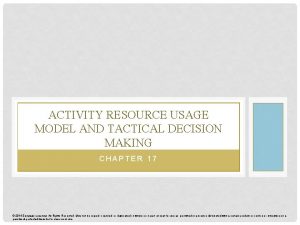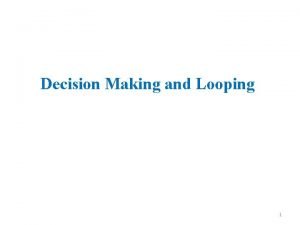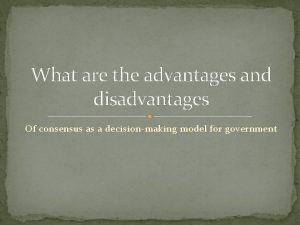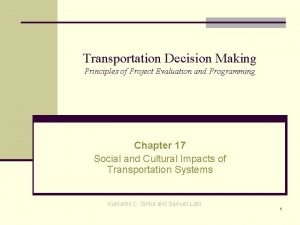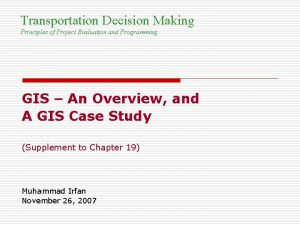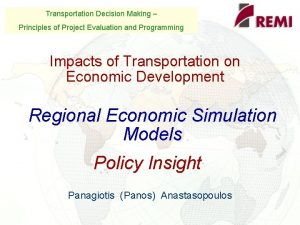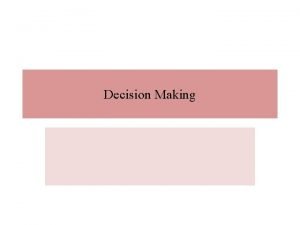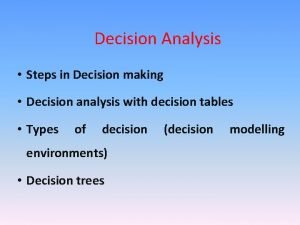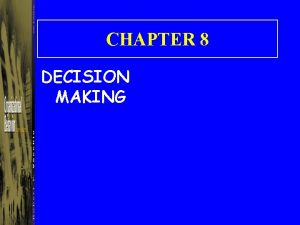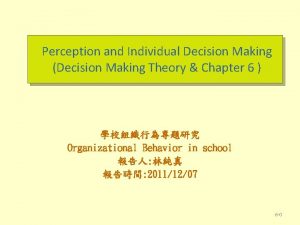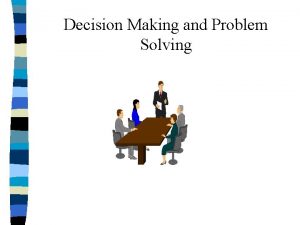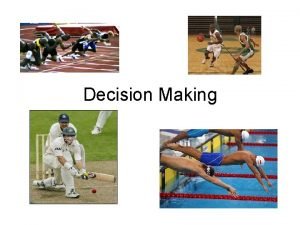Transportation Decision Making Principles of Project Evaluation and































- Slides: 31

Transportation Decision Making Principles of Project Evaluation and Programming Chapter 16 Impacts of Transportation Systems on Land-use 1 Kumares Sinha and Samuel Labi

Land Use Impacts – Are they for real? Consider Monroe county in Indiana Does not have an interstate passing through Interstate 69 is planned to pass through the state Expected construction completion: Year 2015 Between 2015 and 2025, would you expect any changes in: % agricultural land number of shops per acre number of people per acre, etc. ? 2

Transportation-Land Use Relationship Key past studies: 1826 – Johann Henrich von Thunen Studied relationship between price of land accessibility to activity centers 1960 – Alonso Studied relationship between rent and transportation availability 1996 -2003 – Cervero Studied 2 -way relationships between transportation and land-use 1999 – Parsons (NCHRP Report 423 A) Summarized land-use impacts of highway and transit investments 3

Performance Measures for Land-use Impact Assessment Transportation can affect Land-use in many ways: Land-use fractions (land-areas) % agricultural % residential % commercial % industrial other Land-use intensities price of land ($ per acre) residential density (nr. pf people per sq. mile) commercial density (nr. of businesses per sq. mile) 4 etc.

Transportation-Land Use Relationship Is Transportation a result of Land-use Patterns? Does the transportation system determine the ultimate growth and shape of the land use patterns within its area of influence? OR Are Land-use Patterns a result of Transportation system? Do land use patterns determine the form of the transportation system in an area? 5

Transportation-Land Use Relationship Actually, relationship occurs in both ways: Transportation facilities determine the land-use patterns in an area AND Land-use patterns determine the types and number of transportation systems in an area 6

Transportation-Land Use Relationship TRANSPORTATION Change in Activity Patterns Change in Accessibility, and Mobility. LAND USE 7

Transportation-Land Use Relationship TRANSPORTATION Activity Patterns Accessibility LAND USE How does transportation affect land-use? Generally: - By providing or increasing accessibility to and from activity centers (opening up of formerly inaccessible areas) -By increasing mobility (faster, more convenient travel between areas) Specifically: 8 - depends on type of transportation intervention (next slide)

Transportation-Land Use Relationship by type of transportation intervention 9 Modified from: Parsons, 1990)

Transportation-Land Use Relationship TRANSPORTATION Activity Patterns Accessibility LAND USE Transportation impacts on land-use: Are they large or small? Depends on: - type of the transportation intervention - scale of the transportation intervention - maturity (level of development) of existing transportation system - maturity of existing land-use system - the 10 land-use performance measure of interest

Transportation-Land Use Relationship TRANSPORTATION Activity Patterns Accessibility LAND USE Influence of Intervention type - example: Highways impacts are more diffused Direct impacts: ROW (acquisitions, displacements) Indirect or induced impacts: attraction of new development Transit impacts are more localized Direct impacts: ROW, terminals (acquisitions, displacements) Indirect or induced impacts: attraction of new development 11

Transportation-Land Use Relationship TRANSPORTATION Activity Patterns Accessibility LAND USE ? ? ? ? Do other factors (besides Transportation) Affect Land-use? 12

Transportation-Land Use Relationship Other Land-use factors besides Transportation 13

Transportation-Land Use Relationship - Elasticities What is “Land-use Elasticity” with respect to transportation supply? Is the % change in some land-use performance measure with respect to a unit % change in transportation supply Examples: Increase in area of commercial activities for every mile of new road Increase in residential density after building new transit line What is “Land-use Elasticity” with respect to transportation demand? Is the % change in some land-use performance measure with respect to a unit % change in transportation demand Examples: Increase in area of commercial activities for every 1% increase in VMT Increase in number of businesses in an area for every 1% increase in passenger-trips 14

Transportation-Land Use Relationship - Elasticities Land-use Elasticities: Are they important? Help calculate the land-use impacts in response to incremental changes in transportation supply or demand LU elasticities can vary widely What are the influential factors of Land-use elasticities? - type and scale of the transportation system intervention - maturity (level of development ) of existing transportation system before the intervention - maturity of existing land-use system before the intervention - the land-use performance measure of interest 15

Transportation-Land Use Relationship - Elasticities Transportation System Action Elasticity of its Impact on Land Use New facilities (i. e. highway corridors, interchanges) high Added lanes, intersections high System management low Congestion pricing high Parking pricing, management high Vehicle, fuel tax moderate Transportation demand management low Safety improvements low Parsons, 1990 16

How do we estimate Impacts of a proposed Transportation project on Land-use? § Identify the type, scope, etc. of the transportation intervention § Define desired time and spatial scopes of the impacts § Define performance measures of interest § Establish existing transportation and land-use conditions (base conditions) § Establish post-intervention land-use conditions § Repeat for other transportation alternatives 17

Transportation-Land Use Relationship – The Steps 18

Temporal Dimension of Land-use Impacts Time Dimension (short-term/long-term) l Short-term (a few days-months) l Long-term (many years) Land-use impacts are mostly long-term – only a few LU performance measures change in the short term. Spatial Dimension (may be small or very large) 19

Determining the Existing (Base-Case) Conditions – Collect data on: l l – Demographics Housing and Public Policies Travel patterns etc, . Tools for the data collection: l 20 Surveys, statistical analysis, GIS

Impact Assessment–Tools for the Analysis Qualitative Tools Expert panels Quantitative Tools Interviews/Surveys Allocation Rules Decision rules Case studies Statistical methods Etc. Computer Models Etc. 21

Analysis for Impact Assessment– Qualitative Tools (continued) ¢ Expert panels l Delphi ¢ Interviews / Surveys ¢ Case studies l 22 Comparable situations

Analysis for Impact Assessment– Quantitative Tools (continued) ¢ Allocation rules l Constant share - Same growth to all zones l Share of growth / shift-share - Based on recent growth trends l Gravity model - See example 16 -1 23

Analysis for Impact Assessment– Quantitative Tools (continued) l Decision rules - Rules of thumb l Statistical methods - Regression analysis (Tables 16. 9/16. 10) - Property values or commercial development - Discrete choice models - Household or business location decisions 24

Analysis for Impact Assessment– Quantitative Tools (continued) l Computer models • Travel demand - Change in travel patterns • Economic (e. g. , REMI) - Change in population/employment • Land-use (e. g. , METROSIM, TELUS) - Change in land use patterns and development • Integrated models (e. g. , MEPLAN, TRANUS) 25

4. Land Use Impacts after the Transportation Intervention – Forecasts: l l – New travel patterns Change in accessibility Population & employment growth New land use patterns Tools: l l 26 Expert interviews Statistical analysis Travel demand & freight models Integrated transportation and land use models

Mitigation of Adverse Land-use Impacts When? l In case of any undesirable or environmentally adverse land use changes What? l l l 27 avoiding minimizing rectifying reducing and/or compensating with a substitute

Useful Resources for Land-use Impact Analysis 1. NCHRP Report 423 A 2. Wis. DOT (1996) 3. Urban Land Institute 4. Victoria Transport Policy Institute 5. Cervero’s studies (see text for 4 of these) 6. I-69 & DART examples 28

Assessing the Impacts of All Non-user Impacts: Legal Background ¢ 1969 - NEPA l ¢ EIS 1990’s and 2000 s - Transportation Bills l l l 29 ISTEA (1991) TEA (1998) SAFETEA-LU (2005)

Summary of Key Points 1. The Transportation/Land-use Relationship 2. Elasticities 3. Tools for LU Impact Assessment l 4. 5. 30 Qualitative/ Quantitative Impact Framework l Steps l State-of-the-practice Legislation

Questions? 31
 Objectives of decision making
Objectives of decision making Investment decision financing decision dividend decision
Investment decision financing decision dividend decision Principles of decision making
Principles of decision making Project evaluation in software project management
Project evaluation in software project management Decision tree and decision table examples
Decision tree and decision table examples Mamdm
Mamdm Using functions in models and decision making
Using functions in models and decision making Chapter 6 prices and decision making assessment answers
Chapter 6 prices and decision making assessment answers Hoy-tarter model
Hoy-tarter model Decision making and relevant information
Decision making and relevant information Best books on problem solving and decision making
Best books on problem solving and decision making Individual and group decision making
Individual and group decision making Individual and group decision making
Individual and group decision making Perception and individual decision making
Perception and individual decision making Chapter 11 decision making and relevant information
Chapter 11 decision making and relevant information Individual and group decision making
Individual and group decision making Chapter 2 economic systems and decision making
Chapter 2 economic systems and decision making Decision making and branching example
Decision making and branching example Elements of planning
Elements of planning Horizontal solutions group synergy
Horizontal solutions group synergy Management chapter 5 planning and decision making
Management chapter 5 planning and decision making Perception and individual decision making
Perception and individual decision making Decision making goal setting
Decision making goal setting Chapter 2 economic systems and decision making
Chapter 2 economic systems and decision making Individual and group decision making
Individual and group decision making Activity resource usage model and tactical decision making
Activity resource usage model and tactical decision making Activity resource usage model and tactical decision making
Activity resource usage model and tactical decision making Decision making process definition
Decision making process definition Counter-controlled
Counter-controlled Cross cultural negotiation and decision making
Cross cultural negotiation and decision making Chapter 11 decision making and relevant information
Chapter 11 decision making and relevant information Advantages of consensus
Advantages of consensus


